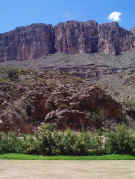

|
|
|
Rio Grande
Wild & Scenic RiverThe National Park Service at the Rio Grande Wild and Scenic River preserves and protects free-flowing and natural and scenic conditions of the river and its immediate environment for the benefit and enjoyment of present and future generations.
In 1978, Congress designated a 196-mile portion of the Rio Grande from the Chihuahua/Coahuila state line in Mexico to the Terrell/Val Verde county line in Texas as part of the National Wild and Scenic Rivers System. The upper 69-mile section of this 196-mile corridor lies within Big Bend National Park. The Wild and Scenic Rivers Act of 1968 directs that designated rivers “...be preserved in free-flowing condition, and that they and their immediate environments be protected for the benefit and enjoyment of the present and future generations.” Big Bend National Park administers this 196-mile section as the Rio Grande Wild and Scenic River.
The NPS’s jurisdiction on the Rio Grande Wild and Scenic River downstream from the park boundary includes only the river area from the United States/Mexico international boundary in the middle of the deepest channel to the gradient boundary at the edge of the river on the United States’ side. The gradient boundary, as recognized by the state of Texas, is defined as located midway between the lower level of the flowing water that just reaches the cut bank and the higher level of it that just does not overtop the cut bank. The river bed of the section of the Wild and Scenic River downstream from the park is the property of the state of Texas.

The stretch of river is classified as either wild or scenic. Wild sections are defined as “...those rivers or sections of river that are free of impoundments and generally inaccessible except by trail, with watershed or shorelines essentially primitive and water unpolluted...these represent vestiges of primitive America....” Scenic sections pertain to “...those rivers or sections of rivers that are free of impoundments, with shorelines or watersheds still largely primitive and shorelines largely undeveloped, but accessible in places by roads....”
The following sections are classified as wild: Talley to Solis, which includes Mariscal Canyon; the entrance to Boquillas Canyon to the exit of Boquillas Canyon; and Reagan Canyon to San Francisco Canyon (the bulk of the “Lower Canyons”). The remainder of the Wild and Scenic River is classified as scenic.
Rio Grande Wild and Scenic River’s Purpose
The purpose of the Rio Grande Wild and Scenic River is to:
- preserve the free-flowing condition, except as provided by international treaties, and essentially primitive character of the river.
- protect the scenic, geologic, fish and wildlife, recreational, scientific, and other similar values along the river way.
- provide opportunities for river-oriented recreation, which is dependent upon the free-flowing condition of the river and consistent with the primitive character of the surroundings.
Rio Grande Wild and Scenic River’s Significance
The Rio Grande Wild and Scenic River is a free-flowing river with a sufficient volume of water during normal years to permit full enjoyment of river recreational activities.
The Rio Grande Wild and Scenic River is part of a valuable ecological system that represents the major riparian and aquatic habitat associated with the Chihuahuan Desert. Its isolation has created an outpost for rapidly dwindling and irreplaceable natural resources.
The spectacular river canyons, the primitive character of the river, and its international flavor provide a stimulating environment for a high quality recreational and scenic experience.
A valuable opportunity exists for binational cooperation between the United States and Mexico to protect and manage this outstanding primitive resource.
Help us plan the future of the Rio Grande Wild & Scenic River
general management plan